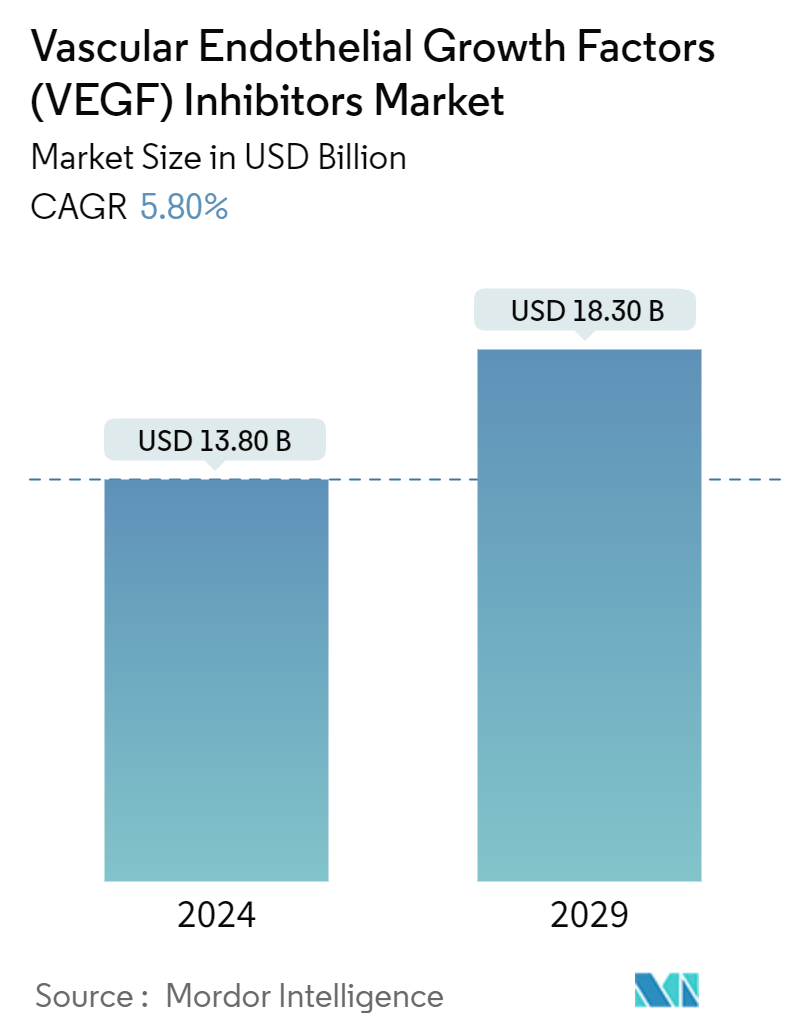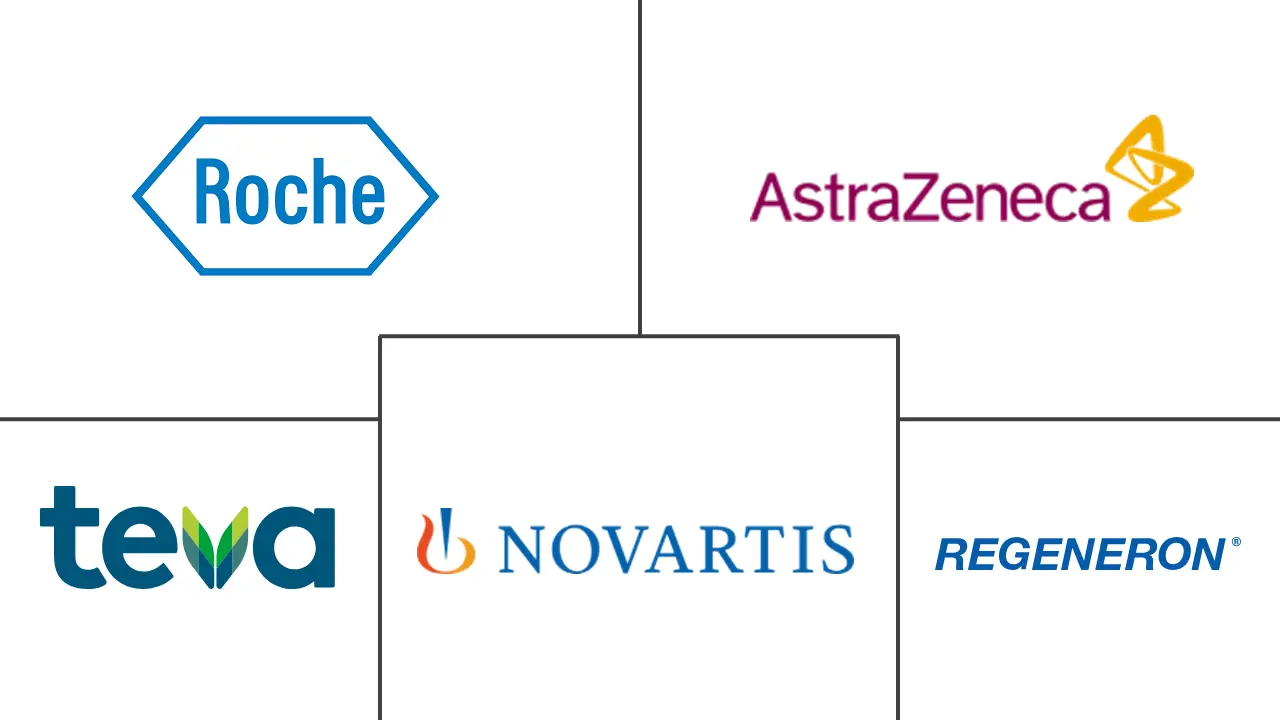Market Size of Vascular Endothelial Growth Factors (VEGF) Inhibitors Industry

| Study Period | 2019 - 2029 |
| Market Size (2024) | USD 13.80 Billion |
| Market Size (2029) | USD 18.30 Billion |
| CAGR (2024 - 2029) | 5.80 % |
| Fastest Growing Market | Asia Pacific |
| Largest Market | North America |
| Market Concentration | Medium |
Major Players
*Disclaimer: Major Players sorted in no particular order |
Vascular Endothelial Growth Factors (VEGF) Inhibitors Market Analysis
The Vascular Endothelial Growth Factors Inhibitors Market size is estimated at USD 13.80 billion in 2024, and is expected to reach USD 18.30 billion by 2029, growing at a CAGR of 5.80% during the forecast period (2024-2029).
Vascular endothelial growth factor (VEGF) inhibitors hinder the activity of VEGF and its receptors (VEGFR). These molecules are vital in forming new blood vessels, also known as angiogenesis. Vascular endothelial growth factor (VEGF) inhibitor drugs reduce blood vessel leakage and stop the growth of abnormal blood vessels. This abnormal blood vessel growth in the eye leads to low vision or blindness and damages the eye. Vascular endothelial growth factor (VEGF) inhibitors or anti-vascular endothelial growth factor (VEGF) drugs block VEGF to hinder the growth of blood vessels and improve the eye’s vision.
According to a study published in the Cureus Journal in September 2022, age-related macular degeneration (AMD) affects about one in eight persons aged 60 years and above in developed countries. It is estimated to affect 200 million people around the world. Although most AMD cases occur in Caucasians, African Americans and Asians are more likely to develop AMD. Furthermore, the study shows that the prevalence of AMD is expected to rise to almost 300 million people worldwide by 2040. Age-related macular degeneration (AMD) is caused by abnormal blood vessels forming under the macula in the eye. These abnormal blood vessels leak fluid, which disrupts the typical structure of the retina and causes the macula to become damaged. Early indications of age-related macular degeneration (AMD) are distorted vision (metamorphosis) and difficulty seeing things.
The growing prevalence of age-related macular degeneration (AMD) and the effectiveness of anti-vascular endothelial growth factor (VEGF) drugs as a treatment option all contribute to the growth of the vascular endothelial growth factor (VEGF) inhibitors market. This large and growing patient base creates significant demand for anti-vascular endothelial growth factor (VEGF) treatment to manage the disease. Therefore, this drives the market as patients seek effective treatments to preserve their sight.
However, the adverse effects associated with the utilization of VEGF inhibitors and preference for gene therapy will restrain market growth.
Vascular Endothelial Growth Factors (VEGF) Inhibitors Industry Segmentation
The vascular endothelial growth factor inhibitors are substances that inhibit VEGF/VEGFR activity. The vascular endothelial growth factor receptor (VEGFR) signaling modulates angiogenesis. Angiogenesis is the process of making new blood vessels by removing existing blood vessels.
The vascular endothelial growth factors (VEGF) inhibitors market is segmented into type, application, route of administration, end user, and geography. By type, the market is VEGF-A, VEGF-B, VEGF-C, and VEGF-D. By treatment, oncology, ophthalmology, and others (arthritis, cardiovascular diseases, etc.). By route of administration, intravenous and oral. By end user, hospitals, specialty clinics, and others (ambulatory surgical centers, home care settings, etc.). By geography, the market is segmented into North America, Europe, Asia-Pacific, South America, and Middle East and Africa. The report also offers the market size and forecasts for 17 countries across the region. For each segment, the market sizing and forecasts were made on the basis of value (USD).
| By Type | |
| VEGF-A | |
| VEGF-B | |
| VEGF-C | |
| VEGF-D |
| By Application | |
| Oncology | |
| Ophthalmology | |
| Other Applications |
| By Route of Administration | |
| Intravenous | |
| Oral |
| By End User | |
| Hospitals | |
| Specialty Clinics | |
| Other End Users |
| Geography | ||||||||
| ||||||||
| ||||||||
| ||||||||
| ||||||||
|
Vascular Endothelial Growth Factors (VEGF) Inhibitors Market Size Summary
The vascular endothelial growth factor (VEGF) inhibitors market is poised for significant growth, driven by the increasing prevalence of age-related macular degeneration (AMD) and the rising global cancer burden. VEGF inhibitors play a crucial role in managing conditions like AMD by blocking the formation of abnormal blood vessels that can lead to vision loss. The effectiveness of these inhibitors in treating various cancers further propels market expansion, as they disrupt the nutrient supply to tumors, slowing their growth. The demand for these treatments is bolstered by a large and growing patient base, particularly in North America, where the aging population and high incidence of AMD create a substantial need for effective therapies.
The market landscape is highly competitive, with major players such as F. Hoffmann-La Roche Ltd, AstraZeneca, and Regeneron Pharmaceuticals Inc. leading the charge. Recent advancements, such as the FDA approval of EYLEA HD by Regeneron Pharmaceuticals, highlight the ongoing innovation in the field. Collaborations and new product launches, like STADA and Xbrane's Ximluci® in Germany, further illustrate the dynamic nature of the market. Despite the promising growth prospects, challenges such as adverse effects and the preference for gene therapy may restrain market expansion. Nonetheless, the confluence of technological advancements, increasing disease awareness, and robust healthcare spending continues to drive the demand for VEGF inhibitors.
Vascular Endothelial Growth Factors (VEGF) Inhibitors Market Size - Table of Contents
-
1. MARKET DYNAMICS
-
1.1 Market Overview
-
1.2 Market Drivers
-
1.2.1 Advancements in Clinical Pipeline Analysis
-
1.2.2 Rising Prevalence of Age-Related Macular Degeneration
-
1.2.3 Growing Popularity of Combination Therapies
-
-
1.3 Market Restraints
-
1.3.1 Rising Preference for Gene Therapy
-
-
1.4 Porter's Five Force Analysis
-
1.4.1 Threat of New Entrants
-
1.4.2 Bargaining Power of Buyers/Consumers
-
1.4.3 Bargaining Power of Suppliers
-
1.4.4 Threat of Substitute Products
-
1.4.5 Intensity of Competitive Rivalry
-
-
-
2. MARKET SEGMENTATION (Market Size by Value - USD)
-
2.1 By Type
-
2.1.1 VEGF-A
-
2.1.2 VEGF-B
-
2.1.3 VEGF-C
-
2.1.4 VEGF-D
-
-
2.2 By Application
-
2.2.1 Oncology
-
2.2.2 Ophthalmology
-
2.2.3 Other Applications
-
-
2.3 By Route of Administration
-
2.3.1 Intravenous
-
2.3.2 Oral
-
-
2.4 By End User
-
2.4.1 Hospitals
-
2.4.2 Specialty Clinics
-
2.4.3 Other End Users
-
-
2.5 Geography
-
2.5.1 North America
-
2.5.1.1 United States
-
2.5.1.2 Canada
-
2.5.1.3 Mexico
-
-
2.5.2 Europe
-
2.5.2.1 Germany
-
2.5.2.2 United Kingdom
-
2.5.2.3 France
-
2.5.2.4 Italy
-
2.5.2.5 Spain
-
2.5.2.6 Rest of Europe
-
-
2.5.3 Asia-Pacific
-
2.5.3.1 China
-
2.5.3.2 Japan
-
2.5.3.3 India
-
2.5.3.4 Australia
-
2.5.3.5 South Korea
-
2.5.3.6 Rest of Asia-Pacific
-
-
2.5.4 Middle East and Africa
-
2.5.4.1 GCC
-
2.5.4.2 South Africa
-
2.5.4.3 Rest of Middle East and Africa
-
-
2.5.5 South America
-
2.5.5.1 Brazil
-
2.5.5.2 Argentina
-
2.5.5.3 Rest of South America
-
-
-
Vascular Endothelial Growth Factors (VEGF) Inhibitors Market Size FAQs
How big is the Vascular Endothelial Growth Factors Inhibitors Market?
The Vascular Endothelial Growth Factors Inhibitors Market size is expected to reach USD 13.80 billion in 2024 and grow at a CAGR of 5.80% to reach USD 18.30 billion by 2029.
What is the current Vascular Endothelial Growth Factors Inhibitors Market size?
In 2024, the Vascular Endothelial Growth Factors Inhibitors Market size is expected to reach USD 13.80 billion.

